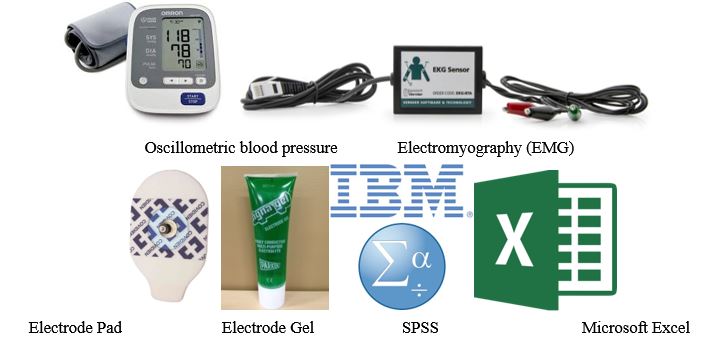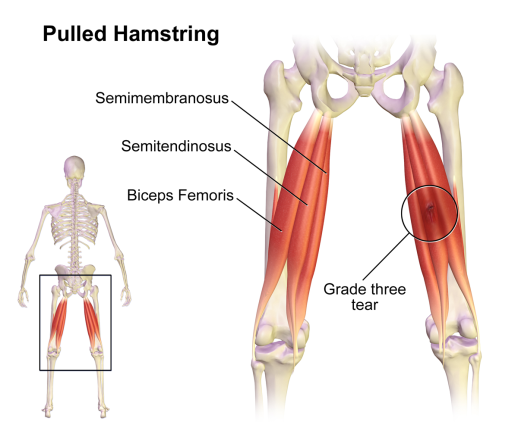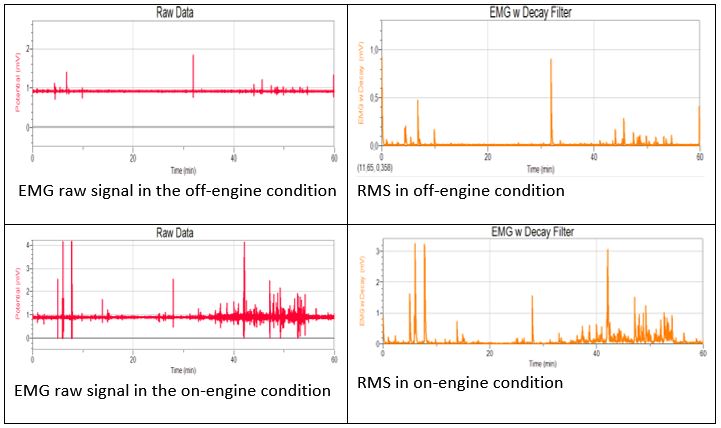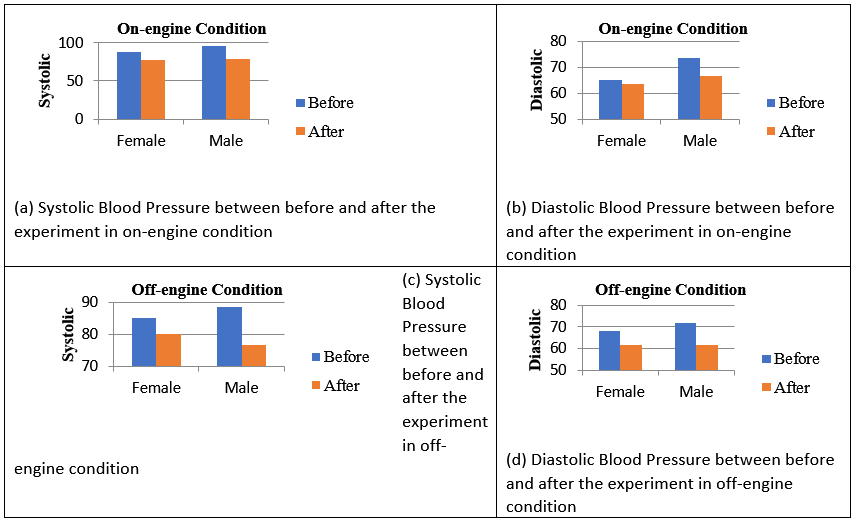Abstract
Commonly, the motorcycle riders are in an astride position during the trip. They placed the legs on a pedal by the same token of passengers. It will produce the inner-thigh pressure which leads to the transient paresthesia in the form of an insufficient blood supply. Oftentimes the syndrome is experienced by children of 3-4 years old. The objective of this study is to investigate the health impact on the upper legs based on muscle contraction. The empirical study is conducted to record the signal of muscle contraction by attaching some sensors on Semimembranosus muscle area. Six males and six females of children were involved in the experiment. Blood pressure was also measured to identify the blood flow. The result of this study found that the contraction of semimembranosus muscle has the difference between male and female with average RMS value are 0.57 mV and 0.17 mV respectively in on-engine condition and 0.1 mV and 0.05 mV respectively in off-engine condition. The blood pressure value of systolic and diastolic have the average value of 88.33/65 mmHg before the experiment, 76.67/63.33 mmHg after experiment for male and 95/73.33 mmHg before the experiment, 78.33/66.67 mmHg after the experiment for female. Those values showed that the prolonged sitting in on-engine condition is having higher muscle fatigue than off-engine for both, male and female.
Keywords: ParesthesiaBlood PressureMuscle contractionElectromyographyMotorcycle
Introduction
The motorcycle is a popular vehicle for middle to low-level society. It is considered an economic transportation mode to make a short or long trip or just to go around the city. Therefore, many people use this vehicle because of its flexibility. Traffic demand also lead motorcycle to be chosen as a private vehicle (Wandani, Siti, Yamamoto, & Yoshida, 2016). According to Indonesian statistical centre bureau (BPS), the amount of the motorcyclist in Indonesia is highest in 2016 as much 105.150.082 million and it will increase continuously (Badan Pusat Statistik, 2018). Indonesia is one of the circumstances where motorcycles are utilized as family vehicles which is usually children tend to travel as pillion riders at an early age, most commonly seated in front of the rider, either on fuel tank or in the carrying basket or alternatively behind the rider (Paiman, et. al., 2014).
As stated in Indonesia constitution number 22 of 2009 on Road Traffic and Transportation Article 106 paragraph (9) that "Every person who drives a motorcycle without an additional train is prohibited in carrying passenger more than 1 (one) person". It means that the motorcycle is for 2 passengers. In fact, according to the preliminary study that has been done with 15 interviewees, most of them used a motorcycle for bringing more than 1 passenger for longer 2 hours of a long trip. The passenger's sitting position during riding motorcycle is even in astride-sitting and sideways. The standard position of motorcycle passenger is astride-sitting as it is designed with two pedals on each side. For those passengers in 3-4 years old does not be able to put their foot on the footrest or hang up/down. It because of no facilities to support the passenger's feet. Moreover, for children whose age are 3-4 years old, the seat depth is not suitable to them that were too shallow increased muscle work, thus increasing fatigue and discomfort (Oguntibeju, Owonuwa, & Odunaiya, 2014). Since movement skills supported by the muscle that used for daily activity needs physical fitness. Muscular strength and balance are latent by nature. Gender differences have the different motor response as its physical exertion phenomenon in the potential of physical fitness and movement skills (Ikeda & Aoyagi, 2009). The footrest is needed for motorcyclist and passenger to make a balance of the upper body and legs as well as avoiding a fatigue. But it is currently designed suitable for those who are adequately tall (Amrutkar & Rajhans, 2017). This condition will produce the inner-thigh pressure which occluded blood supply then it leads to transient paresthesia (Alhoseini, et. al., 2012). As stated by Shivakumara and Sridhar, (2010), the blood is having the role to give the muscle energy to get muscular system activity. The measurement of blood pressure is needed to know whether there is the decreasing or increasing the blood flow and the blood flow pressure impact on the semimembranosus muscle during riding motorcycle to avoid transient paresthesia.
Transient Paresthesia is an abnormal sensation of burning, numbness, tingling, itching or prickling caused by the insufficient blood supply to muscle so as inflicting muscle fatigue at the bottom of the thigh (Alhoseini, et al., 2012). A study from Suhardi,
The Hamstring muscle is located between the hip and knee behind the thigh area. It is composed of three muscle bellies of Bicep Femoris, Semitendinosus and Semimembranosus muscle. The muscle location which from medial hamstring and lateral hamstring is Semimembranosus, Semitendinosus, and Biceps Femoris muscle (Onishi et al., 2002). The astride-sitting position is having contact to the lower extremities of buttock pressure, and another system around the seat. for those who cannot reach the pedal, the inner thigh surface will be pressed as it balances the physical human posture (Balasubramanian & Jagannath, 2014). In this case, the semimembranosus muscle is involved as its location in the inner of the thigh while the hamstrings are contributed in hip and knee postural flexion (Higashihara, et. al., 2014).
To know the muscle activity, the Electromyography (EMG) is used for measuring muscle contraction through the electrical signal that could be detected by using an electrode pad. It is one of the ergonomic purposes to measure how the design can cause the physical injury to the user (Konrad, 2005). As recognized by many research works, surface electromyography (sEMG) is one of the reliable devices used to evaluate muscle fatigue that is safe for use as it is affixed skin surface to know the muscle activity (Criswell, 2011). Windblast, vibration, noise, and motion is an environmental element that could be (Rashid et al., 2017). This research involves the vibration that could give impact to blood pressure. Static vibration will cause the blood flow not smooth where the accumulation of the lactic acid increase leading multifunctional muscle pain (NIOSH, 1997). The magnitude of EMG activation was determined using three methods: peak RMS (pRMS), mean RMS (mRMS) and integrated EMG (iEMG). Peak RMS was the maximum value of the RMS signal during the stance phase of gait. Conversely, mean RMS was the mean of the RMS signal during the stance phase of gait. For the integrated EMG analysis, EMG signals were integrated across the stance phase of gait (Renshaw, Bice, Cassidy, James, & Powell, 2010). Thus, the objective of this study is to investigate the muscle contraction of children’s inner thigh for motorcycle passenger by using Surface Electromyography and the signal calculated by mRMS to get the amplitude.
Problem Statement
Ideally every person who drives a motorcycle should carry passenger only one. It means that the motorcycle is for 2 passengers. Therefore, they can sit comfortably and be able to put their foot on the footrest or pedals. In fact, most of them used a motorcycle for bringing more than 1 passenger for longer two hours of trip where the passenger sits with the foot is in hang up/down especially for children passenger. It because of no facilities to support the passenger's feet as well as the seat depth is not suitable to them. Consequences of this condition will increase muscle work and produce the inner-thigh pressure which occluded blood supply then it leads to transient paresthesia. Thus the footrest is needed for motorcyclist and passenger to make a balance of the upper body and legs as well as avoiding a fatigue and discomfort.
Research Questions
How is the effect of prolonged sitting on the motorcycle as the passenger at Semimembranosus muscle contraction and blood pressure using Surface Electromyography (sEMG) and Oscillometric blood pressure and what is the difference between male and female?
Purpose of the Study
-
To Evaluate the Semimembranosus muscle contraction in thigh based on the EMG signal when riding the motorcycle as a passenger between male and female passengers.
-
To Evaluate the blood pressure when riding a motorcycle as a passenger
Research Method
Subject
The subject of the study are 6 males and 6 females. Their age is 3-4 years old which each of them was involved for two machine conditions, off and on. No activities before experiment was done by participant to avoid early fatigue and free from any medications or lifestyle treatments that will influence blood pressure and muscle (Kaur et al., 2015).
Apparatus
In this study, a motorcycle with 0,06 m/s2 vibration is required as a stimulus. Electromyography (Lab Quest 2: Vernier Tech & Soft, Texas, USA) is used to identify the contraction of a spesific muscle by attaching the electrode at the muscle. The data recorded by Lab Quest 2 will be directly transfered to Logger pro software to quantify some electric signal into filtered EMG data. While The blood pressure data was recorde by using an Oscillometric blood pressure device to provide the comparison between respondent's pre and post-experiment blood pressure. The data was processed statistically using the Statistical Package for the Social Science (SPSS) software version 22.

Experiment Design
The experiment involves two conditions of motorcycle. They are the on-engine and off-engine which leads the immediate exposure of vibartion to the seat and to whole body (Halim, Omar, Saman, & Othman, 2012). This experiment is performed in the outdoor as it has the ground floor. The electrode is attached at the Semimembranosus muscle where the muscle got pressed by the force of passenger's weight. The semimembranosus muscle is shown in figure 0.2 below:

Task
The subject is instructed to sit on the motorcycle for 1 hour in an off-engine motorcycle and 1 hour in an on-enginer motorcycle in the next day or vice versa. The subject is expected to sit in the same position as they are in a motor riding, the EMG is started to record the signal at Semimembranosus muscle contraction.
Procedure of Experiment
This experiment is done in the outdoor which has the ground floor. The electrode is attached at Semimembranosus muscle to identify contarction. Each subject was participated in each experiment. Before the experiment, the subject should take the position as they are riding on the motorcycle. Then, the electromyography wire attaches to the attached electrode pad to record it by using logger pro for 1 hour in off-engine condition. On the next day, they continue to the on-enginee condition for 1 hour as well. Each pre and post-experiment, the respondent's blood pressure will be check.
Statistical Analysis
EMG signal data analysis is done using signal analysis and the parametric statistical analysis method. Blood pressure data is analyse using the descriptive statistics. The mean root mean square (mRMS) is used as parameter of the muscle contraction. The paired and independent T-Test and Descriptive statistics is carried out to identify the difference between experiment condition and gender.
Findings
Semimembranosus Muscle Contraction Analysis

Figure
Table
At conditions of the on-engine and the off-engine condition have different muscle contraction which male tends to have higher amplitude during the on-engine condition and also during the off-engine condition than female. In some experimental study conducted by Ahamed et al., (2015) and Cioni, et. al., (1988), it was found that male has higher a muscle contraction than female where male’s muscle signal generated higher and steadier. Male’s skeletal muscles are generally faster and have higher maximum power output than female’s muscles. While Glenmark (2004) express that, female’s muscles are generally more fatigue resistant and recover faster during repeated contractions.
The comparison of mRMS of each subject between the on-engine and the off-engine condition is shown in Table 0.1. Result of the paired independent T-test presents that the difference of male during the on-engine and the off-engine condition has significance value of 0,028 where the p-value is less than 5% or 0,05. It means that hypoteses one (H1) is accepted. This indicates that male have different muscle contraction between during the on-engine and the off-engine condition. While female during the on-engine and the off-engine condition have a significant value of 0,000012 where the p-value is less than 5% or 0,05. It means that hypoteses one (H1) is accepted. This shows that female have a different muscle contraction between during the on-engine and the off-engine condition. Both different on muscle contraction during the on-engine and the off-engine condition shows that male and female have the higher inclination of amplitude value in the on-engine condition than in the off-engine condition.
Blood Pressure Analysis
Table

The difference in systolic blood pressure between before and after the experiment in the on-engine and the off-engine condition is shown in Figure
The difference in diastolic blood pressure between before and after the experiment in the on-engine and the off-engine condition is shown in the Figure
Figure
As for after the experiment, it is shown in same Figure above where shows that the mean systolic blood pressure after the experiment of female between the on-engine is lower than the off-engine condition. It was affected much by vibartion during the on-engine condition. The figure also shows that the mean systolic blood pressure after the experiment of male between the on-engine is higher than the off-engine condition. It was affected also byd vibration during the on-engine condition. Figure also shows that the diastolic blood pressure between the on-engine and the off-engine condition after the experiment where the mean diastolic blood pressure after the experiment of female between the on-engine is lower than the off-engine condition. The figure also shows that the mean diastolic blood pressure after the experiment of male between the on-engine is higher than the off-engine condition. It was affected by vibartion during on-engine condition.
After the experiment, Systolic blood pressure in the on-engine and the off-engine condition shows that there were decreasing. It is caused by the occluded blood flow during the uncomforted sitting. The edge of the seat pressed the hanging leg. The prolonged uncomforted sitting causes muscle contraction blood pressures decreased due to prolonged lower body immobilization, which causes poor systematic circulation (Balasubramanian et al., 2014). A static position causes damage at the muscular system. It is caused by the muscle rhythm act through the contraction and relaxation to blood flow that brings oxygen and removes the waste secret product from the active muscle. The groups of muscles will make contraction of the muscle in long static position. In these conditions, contractions lead to the occlusion of blood vessels and prevent blood supply and disposal of waste products. This can cause temporary painful muscle cramps, the pain makes one stop by assuming a person's static position and renewing the blood supply to the contracting muscle (Adar, 2004) also the blood flow occluded, the blood supply to the muscular tissue will be blocked as it will also decrease their energy. Hence, it will be dangerous to face prolonged exposure to vibration will cause several diseases such as high blood pressure (Shivakumara & Sridhar, 2010). This condition will produce the inner-thigh pressure which occluded blood supply then it leads to transient paresthesia (Alhoseini et al., 2012).
Conclusion
-
The result of this study found that the contraction of semimembranosus muscle has the difference between male and female with average RMS value are 0,57 mV and 0,17 mV respectively in the on-engine condition and 0,1 mV and 0,05 mV respectively in the off-engine condition. Supported by statistical analysis to compare the experiments within the subject which is 0,014 and 0,000018 and comparison between gender is 0,028 and 0,000012 between male. The amplitude is higher due to the vibration transmission than no-vibration. It will increase since the vibration during real driving is dynamic of the engine operation. The male respondent would likely have higher muscle contraction than female contraction as there are different skeletal muscles between male and female. But, both of them has an increasing amplitude which leads to muscle fatigue.
-
The position of astride sitting made hung legs that weighted to the edge of the motorcycle seat which made high possibility to be pressed over the blood flow. There are decreasing between both female and male in both conditions. The blood pressure value of systolic and diastolic have the average value of 88,33/65 mmHg before the experiment, 76,67/63,33 mmHg after experiment for male and 95/73,33 mmHg before the experiment, 78,33/66,67 mmHg after the experiment for female. The decreasing signs the occlusion of blood flow lead to the accumulation of the lactic acid increasing and block oxygen supplies that lead multifunctional muscle pain that causes insufficient blood supply that makes transient paresthesia.
References
- Adar, B. Z. (2004). Risk Factors of Prolonged Sitting and Lack of physical physical Activity in Relate to Postural Deformities, Muscle Tension and Backache among Israel Children. Budapest.
- Ahamed, N. U., Yusof, Z. B. M., Alqahtani, M., Altwijri, O., Rahman, S. A. M. M., & Sundaraj, K. (2015). Gender Effects in Surface Electromyographic Activity of the Biceps Brachii Muscle during Prolonged Isometric Contraction. Procedia Computer Science, 61, 448–453.
- Amrutkar, A. S., & Rajhans, N. R. (2017). Ergonomic Posture for Motorcycle Riding ., (April 2011).
- Balasubramanian, V., & Jagannath, M. (2014). Detecting motorcycle rider local physical fatigue and discomfort using surface electromyography and seat interface pressure. Transportation Research Part F: Traffic Psychology and Behaviour, 22, 150–158.
- Cioni, R., Giannini, F., Paradiso, C., Battistini, N., Denoth, F., … & Starita, A. (1988). Differences between surface EMG in male and female subjects evidenced by automatic analysis. Electroencephalography and clinical neurophysiology, 70(4), 306-312.
- Criswell, E. (2011). Surface Electromyography. Second Edition. Canada: Jones & Bartlett.
- Glenmark, B. (2004). The difference in skeletal muscle function in males vs. females: the role of estrogen receptors. AJP: Endocrinology and Metabolism, 287(6), E1125–E1131.
- Halim, I., Omar, A. R., Saman, A. M., & Othman, I. (2012). Assessment of Muscle Fatigue Associated with Prolonged Standing in the Workplace. Safety and Health at Work, 3(1), 31–42.
- Joyner, M. J., & Casey, D. P. (2015). Regulation of Increased Blood Flow (Hyperemia) to Muscles During Exercise. A Hierarchy of Competing Physiological Needs. Physiological Reviews, 95(2), 549–601.
- Konrad, P. (2005). The ABC of EMG : A Practical Introduction to Kinesiological Electromyography. USA: Noraxon Inc.
- NIOSH. (1997). Musculoskeletal Disorders and Workplace Factors: A Critical Review of Epidemiologic Evidence for Work-Related Musculoskeletal Disorders Musculoskeletal Disorders and Workplace Factors: A Critical Review of Epidemiologic Evidence for Work-Related Musculoskel.
- Oguntibeju, O., Owonuwa, & Odunaiya, N. (2014). Ergonomic suitability of educational furniture and possible health implications in a university setting. Advances in Medical Education and Practice, 1.
- Paiman, N. F., Shabadin, A., Haffez, A., Syazwan, S., & Azhar, H. (2014). Child motorcycle pillion rider anthropometric measurement. AMM, 663, 557-61.
- Rashid, H., Omar, A. R., Ahmad, I. N., Mohamed, Z., Fauzi, W. M. S. W., Mahmud, Z., & Haron, R. (2017). Motorcyclists' prolonged riding simulation: The setup and procedures. Journal of Mechanical Engineering, (5), 197-208.
- Renshaw, D., Bice, M. R., Cassidy, C., James, a, & Powell, D. W. (2010). A Comparison of Three Computer-based Methods Used to Determine EMG Signal Amplitude. International Journal of Exercise Science, 3, 43–48.
- Sharif-Alhoseini, M., Rahimi-Movaghar, V., & Vaccaro, A. R. (2012). Underlying Causes of Paresthesia.
- Shivakumara BS. and Sridhar V. (2010). Study of vibration and its effect on the health of the motorcycle rider. Journal of Health and Allied Sciences, 9(2).
- Soewardi, H., Anugraheni, A. R., & Shabrina, N. (2015). Analysis of Electromyography on Computer Interaction Devices to the Risk of Carpal Tunnel Syndrome.
- Wan, J. J., Qin, Z., Wang, P. Y., Sun, Y., & Liu, X. (2017). Muscle fatigue: General understanding and treatment. Experimental and Molecular Medicine, 49(10), e384-11.
- Wandani, F. P., Siti, M., Yamamoto, M., & Yoshida, Y. (2016). Spatial econometric analysis of automobile and motorcycle traffic on Indonesian national roads and its socioeconomic determinants: Is it local or beyond city boundaries? IATSS Research, (February).
- Www.vernier.com. (n.d.). Logger Pro Now Offers Digital Filtering and New Digital Control Unit Options. Retrieved March 24, 2018, from https://www.vernier.com/news/2012/10/01/logger-pro-now-offers-digital-filtering-and-new-digital-control-unit-options/
Copyright information

This work is licensed under a Creative Commons Attribution-NonCommercial-NoDerivatives 4.0 International License.
About this article
Publication Date
17 May 2019
Article Doi
eBook ISBN
978-1-80296-061-7
Publisher
Future Academy
Volume
62
Print ISBN (optional)
-
Edition Number
1st Edition
Pages
1-539
Subjects
Business, innovation, sustainability, environment, green business, environmental issues
Cite this article as:
Pramita*, E. A., & Soewardi, H. (2019). Muscle Contraction Analysis Of The Prolonged Astride-Sitting On Motorcycle Using Electromyography. In M. Imran Qureshi (Ed.), Technology & Society: A Multidisciplinary Pathway for Sustainable Development, vol 62. European Proceedings of Social and Behavioural Sciences (pp. 524-534). Future Academy. https://doi.org/10.15405/epsbs.2019.05.02.52
